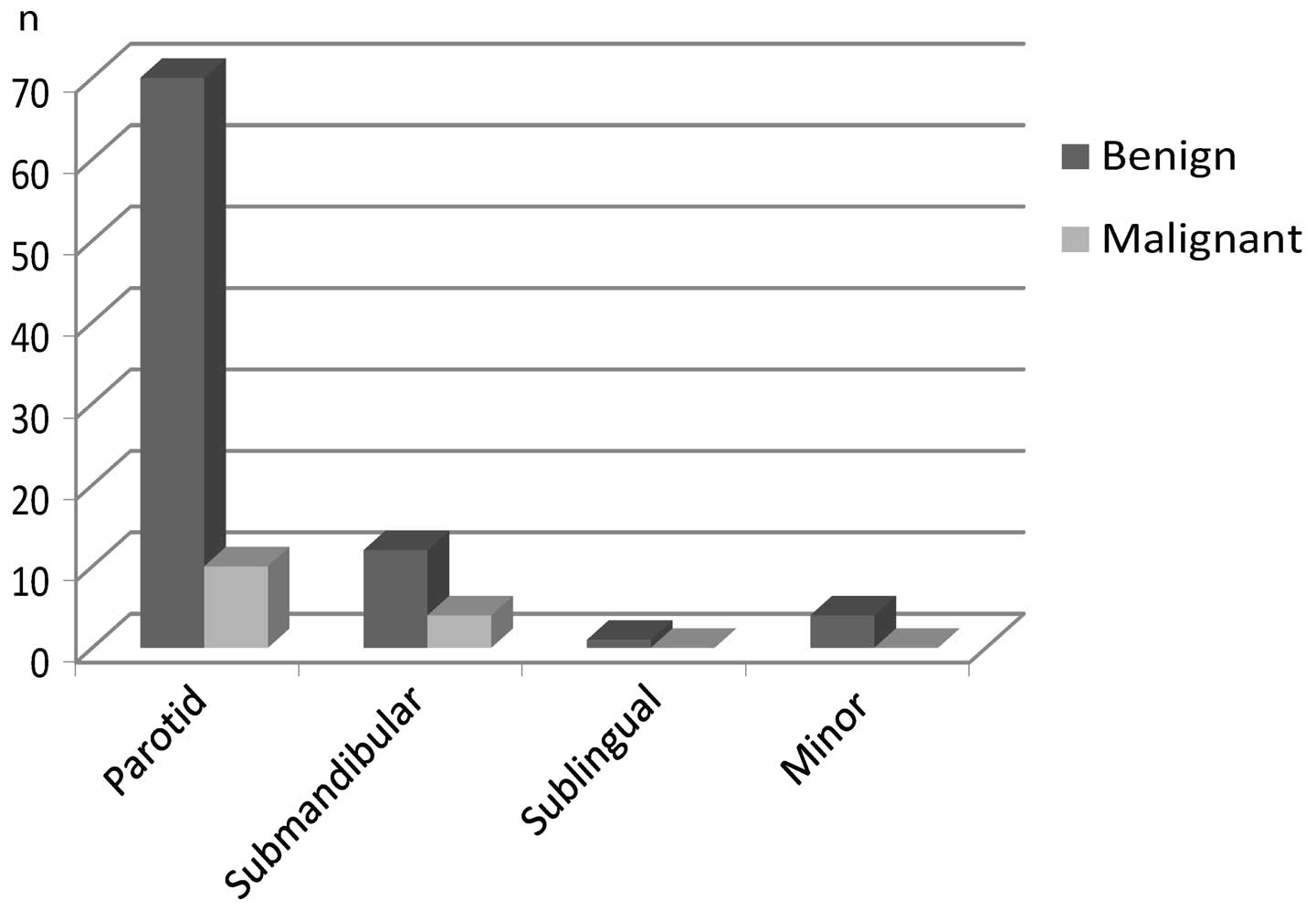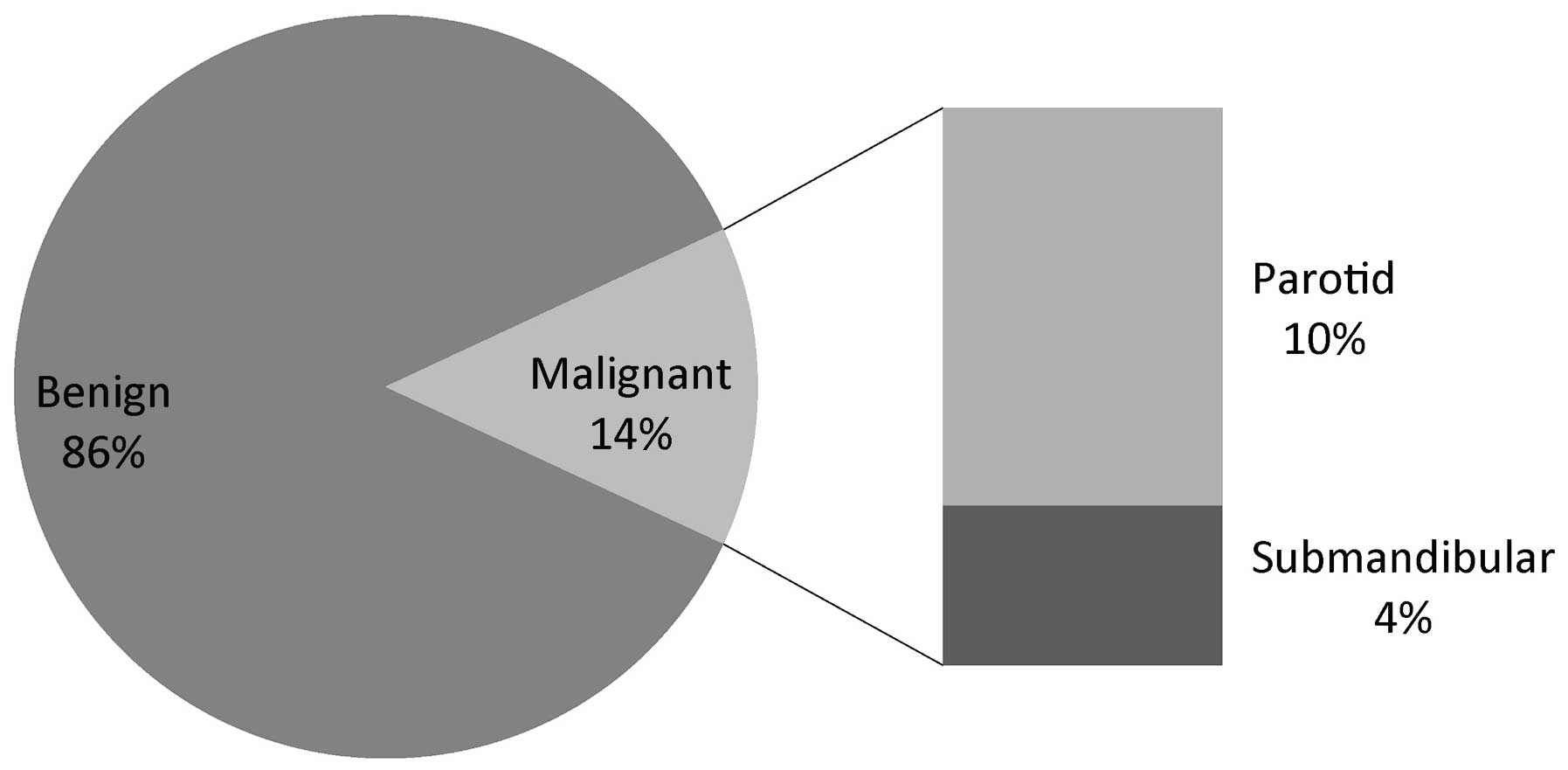|
1
|
Cancer Registry Annual Report. Bureau of
Health Promotion, Department of Health; Taiwan: 2009, http://www.hpa.gov.tw/Bhpnet/Web/Stat/Statistics.aspx.
Accessed August 13, 2012
|
|
2
|
Katoh T, Ishige T, Kasai H, et al:
Malignant parotid gland tumors and facial nerve paralysis. Arch
Otorhinolaryngol. 240:139–144. 1984.PubMed/NCBI
|
|
3
|
Eneroth CM: Facial nerve paralysis. A
criterion of malignancy in parotid tumors. Arch Otolaryngol.
95:300–304. 1972. View Article : Google Scholar : PubMed/NCBI
|
|
4
|
Kechagias N, Ntomouchtsis A, Valeri R, et
al: Fine-needle aspiration cytology of salivary gland tumours: a
10-year retrospective analysis. Oral Maxillofac Surg. 16:35–40.
2012.PubMed/NCBI
|
|
5
|
Taylor MJ, Serpell JW and Thomson P:
Preoperative fine needle cytology and imaging facilitates the
management of submandibular salivary gland lesions. ANZ J Surg.
81:70–74. 2011. View Article : Google Scholar
|
|
6
|
Sharma G, Jung AS, Maceri DR, Rice DH,
Martin SE and Grant EG: US-guided fine-needle aspiration of major
salivary gland masses and adjacent lymph nodes: accuracy and impact
on clinical decision making. Radiology. 259:471–478. 2011.
View Article : Google Scholar
|
|
7
|
Viguer JM, Vicandi B, Jiménez-Heffernan
JA, López-Ferrer P, Gonzalez-Peramato P and Castillo C: Role of
fine needle aspiration cytology in the diagnosis and management of
Warthin’s tumour of the salivary glands. Cytopathology. 21:164–169.
2010.
|
|
8
|
Christensen RK, Bjørndal K, Godballe C and
Krogdahl A: Value of fine-needle aspiration biopsy of salivary
gland lesions. Head Neck. 32:104–108. 2010.PubMed/NCBI
|
|
9
|
Chakrabarti S, Bera M, Bhattacharya PK, et
al: Study of salivary gland lesions with fine needle aspiration
cytology and histopothology along with immunohistochemistry. J
Indian Med Assoc. 108:833–836. 2010.
|
|
10
|
Gonçalves AJ, Menezes MB, Kavabata NK,
Bertelli AA, Souza RA and Joelsons D: Fine needle aspiration in
salivary gland tumors: specificity and sensitivity. Rev Assoc Med
Bras. 53:267–271. 2007.(In Portuguese).
|
|
11
|
Mihashi H, Kawahara A, Kage M, et al:
Comparison of preoperative fine-needle aspiration cytology
diagnosis and histopathological diagnosis of salivary gland tumors.
Kurume Med J. 53:23–27. 2006. View Article : Google Scholar : PubMed/NCBI
|
|
12
|
Cohen EG, Patel SG, Lin O, et al:
Fine-needle aspiration biopsy of salivary gland lesions in a
selected patient population. Arch Otolaryngol Head Neck Surg.
130:773–778. 2004. View Article : Google Scholar : PubMed/NCBI
|
|
13
|
Eng CY, Evans AS, Quraishi MS and Harkness
PA: A comparison of the incidence of facial palsy following
parotidectomy performed by ENT and non-ENT surgeons. J Laryngol
Otol. 121:40–43. 2007.
|
|
14
|
Guntinas-Lichius O, Gabriel B and
Klussmann JP: Risk of facial palsy and severe Frey’s syndrome after
conservative parotidectomy for benign disease: analysis of 610
operations. Acta Otolaryngol. 126:1104–1109. 2006.
|
|
15
|
Wang YL, Li DS, Gan HL, et al: Predictive
index for lymph node management of major salivary gland cancer.
Laryngoscope. 122:1497–1506. 2012. View Article : Google Scholar : PubMed/NCBI
|
|
16
|
Ishinaga H, Kato A and Yamada H: Neck
dissection for salivary gland carcinoma. Nihon Jibiinkoka Gakkai
Kaiho. 101:895–899. 1998.(In Japanese).
|
|
17
|
Medina JE: Neck dissection in the
treatment of cancer of major salivary glands. Otolaryngol Clin
North Am. 31:815–822. 1998. View Article : Google Scholar : PubMed/NCBI
|
|
18
|
Korkmaz H, Yoo GH, Du W, et al: Predictors
of nodal metastasis in salivary gland cancer. J Surg Oncol.
80:186–189. 2002. View Article : Google Scholar : PubMed/NCBI
|
|
19
|
Ivanová S, Slobodníková J, Janská E and
Jozefáková J: Fine needle aspiration biopsy in a diagnostic workup
algorithm of salivary gland tumors. Neoplasma. 50:144–147.
2003.PubMed/NCBI
|
|
20
|
Oka K, Chikamatsu K, Eura M, Katsura F,
Yumoto E and Tokunaga H: Clinical significance of fine-needle
aspiration biopsy in major salivary gland tumors. Nihon Jibiinkoka
Gakkai Kaiho. 105:1109–1115. 2002.(In Japanese).
|
|
21
|
Al-Khafaji BM and Afify AM: Salivary gland
fine needle aspiration using the ThinPrep technique: diagnostic
accuracy, cytologic artifacts and pitfalls. Acta Cytol. 45:567–574.
2001. View Article : Google Scholar
|
|
22
|
Stewart CJ, MacKenzie K, McGarry GW and
Mowat A: Fine-needle aspiration cytology of salivary gland: a
review of 341 cases. Diagn Cytopathol. 22:139–146. 2000. View Article : Google Scholar : PubMed/NCBI
|
|
23
|
Jan IS, Chung PF, Weng MH, et al: Analysis
of fine-needle aspiration cytology of the salivary gland. J Formos
Med Assoc. 107:364–370. 2008. View Article : Google Scholar : PubMed/NCBI
|
|
24
|
Murai N, Taniguchi Z, Takahashi Y,
Yasuhara Y, Kuboshima F and Tateya I: A study of salivary gland
aspiration cytology reporting: guideline validity. Nihon Jibiinkoka
Gakkai Kaiho. 114:615–619. 2011.(In Japanese).
|
|
25
|
Folia M, Kany M, Fillola G, Serrano E and
Pessey JJ: Value of of fine-needle aspiration cytology and MRI in
parotid gland masses. Rev Laryngol Otol Rhinol (Bord). 123:153–157.
2002.(In French).
|
|
26
|
Jafari A, Royer B, Lefevre M, Corlieu P,
Périé S and St Guily JL: Value of the cytological diagnosis in the
treatment of parotid tumors. Otolaryngol Head Neck Surg.
140:381–385. 2009. View Article : Google Scholar : PubMed/NCBI
|
|
27
|
Schmitt G, Lehmann G, Strötges MW, et al:
The diagnostic value of sialography and scintigraphy in salivary
gland diseases. Br J Radiol. 49:326–329. 1976. View Article : Google Scholar : PubMed/NCBI
|
|
28
|
Schall GL, Smith RR and Barsocchini LM:
Radionuclide salivary imaging usefulness in a private
otolaryngology practice. Arch Otolaryngol. 107:40–44. 1981.
View Article : Google Scholar : PubMed/NCBI
|
|
29
|
Isacsson G, Isberg A, Haverling M and
Lundquist PG: Salivary calculi and chronic sialoadenitis of the
submandibular gland: a radiographic and histologic study. Oral Surg
Oral Med Oral Pathol. 58:622–627. 1984. View Article : Google Scholar : PubMed/NCBI
|
|
30
|
Chisin R, Markitziu A, Hoffer S, Shani J
and Atlan H: The clinical value of quantitative dynamic
scintigraphy in salivary gland disorders. Int J Rad Appl Instrum B.
15:313–317. 1988. View Article : Google Scholar
|
|
31
|
Arbab AS, Koizumi K, Toyama K, et al:
Various imaging modalities for the detection of salivary gland
lesions: the advantages of 201Tl SPET. Nucl Med Commun. 21:277–284.
2000. View Article : Google Scholar : PubMed/NCBI
|
|
32
|
Salaffi F, Carotti M, Argalia G, Salera D,
Giuseppetti GM and Grassi W: Usefulness of ultrasonography and
color Doppler sonography in the diagnosis of major salivary gland
diseases. Reumatismo. 58:138–156. 2006.(In Italian).
|
|
33
|
Nakahara T, Suzuki T, Hashimoto J, et al:
Role of salivary gland scintigraphy with Tc-99m pertechnetate in
determining treatment of solitary parotid gland tumors: a
retrospective study. Clin Nucl Med. 32:363–366. 2007. View Article : Google Scholar
|
|
34
|
Klein K, Turk R, Gritzmann N and Traxler
M: The value of sonography in salivary gland tumors. HNO. 37:71–75.
1989.(In German).
|
|
35
|
Prades JM, Oletski A, Faye MB, et al:
Parotid gland masses: diagnostic value of MR imaging with
histopathologic correlations. Morphologie. 91:44–51. 2007.(In
French).
|
|
36
|
Khan N, Oriuchi N, Ninomiya H, Higuchi T,
Kamada H and Endo K: Positron emission tomographic imaging with
11C-choline in differential diagnosis of head and neck
tumors: comparison with 18F-FDG PET. Ann Nucl Med.
18:409–417. 2004.
|
|
37
|
Jeong HS, Chung MK, Son YI, et al: Role of
18F-FDG PET/CT in management of high-grade salivary
gland malignancies. J Nucl Med. 48:1237–1244. 2007.
|












